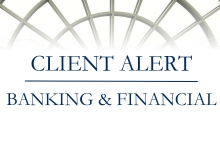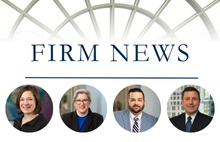SBA Paycheck Protection Program Rule: Guidance for Self-Employed Individuals
April 15, 2020On April 14, 2020, the U.S. Small Business Administration (SBA) issued an interim final rule (the “4/14 Interim Final Rule”) relating to the Paycheck Protection Program (PPP) added to the SBA 7(a) Loan Program under the Coronavirus Aid, Relief, and Economic Security Act (CARES Act). A copy of the 4/14 Interim Rule can be found here. Loans made under the PPP are 100% guaranteed by SBA, and the full principal amount of the loans may qualify for loan forgiveness. For additional information on the PPP, please see our prior alerts on our SBA Loans resource page.
This alert summarizes matters of particular relevance to independent contractors, self-employed individuals, partnerships, and limited liability companies that are interested in applying for a loan under the PPP, as well as to lenders, including whether businesses owned by directors or shareholders of a PPP lender are permitted to apply for a PPP loan, and requirements for certain pledges of PPP loans.
Topics Addressed in the 4/14 Interim Final Rule
Loans for Self-Employed Individuals
The 4/14 Interim Final Rule provides guidance for individuals with self-employment income that desire to apply for a PPP loan, including independent contractors, and states the following:
- Eligibility Guidance. The rule clarifies that individuals with self-employment income are eligible for a PPP loan if:
- they were in operation on February 15, 2020;
- they are an individual with self-employment income (such as an independent contractor or a sole proprietor);
- their principal place of residence is in the United States; and
- they filed or will file a Form 1040 Schedule C for 2019.
- Partners and Limited Liability Company Members are Ineligible. The rule clarifies that partners in a partnership (including limited liability companies taxed as a partnership) cannot submit PPP loan applications as self-employed individuals; instead, the self-employment income of general active partners may be reported as a payroll cost, up to $100,000 annualized per partner (or member), on a PPP loan application filed on behalf of the partnership (or limited liability company).
- Maximum Loan Amount Calculation. The rule provides methodologies for calculating the maximum loan amount that individuals with self-employment income can borrow under the PPP, including how employees factor into the calculation, which are based on the applicant’s 2019 Form 1040 Schedule C (which only reflects expenses between January 1, 2019 and December 31, 2019).
- Guidance on Permitted Uses of Proceeds. The rule provides requirements for and limitations on the use of PPP loan proceeds by individuals with income from self-employment, including that at least 75% of the PPP loan proceeds be used to pay payroll costs (more on that below).
- Guidance on Loan Forgiveness. The rule provides that the actual amount of PPP loan forgiveness for individuals with income from self-employment will depend, in part, on the total amount spent over the covered period on:
- payroll costs including salary, wages, and tips, up to $100,000 of annualized pay per employee (for eight weeks, a maximum of $15,385 per individual), as well as covered benefits for employees (but not owners), including health care expenses, retirement contributions, and state taxes imposed on employee payroll paid by the employer (such as unemployment insurance premiums);
- owner compensation replacement, calculated based on 2019 net profit as shown on the applicant’s Form 1040, Schedule C, line 31, but subject to a $100,000 annualized cap with forgiveness of such amounts limited to eight weeks’ worth (8/52) of 2019 net profit (thus the maximum amount of owner compensation replacement for the 8-week period that could be forgiven is $15,385), but excluding any qualified sick leave equivalent amount for which a credit is claimed under section 7002 of the Families First Coronavirus Response Act (FFCRA) (Public Law 116-127) or qualified family leave equivalent amount for which a credit is claimed under section 7004 of FFCRA;
- payments of interest on mortgage obligations on real or personal property incurred before February 15, 2020, to the extent they are deductible on Form 1040 Schedule C (business mortgage payments);
- rent payments on lease agreements in force before February 15, 2020, to the extent they are deductible on Form 1040 Schedule C (business rent payments); and
- utility payments under service agreements dated before February 15, 2020 to the extent they are deductible on Form 1040 Schedule C (business utility payments).
The rule also confirms that at least 75% of the forgiveness amount must be attributable to payroll costs.
- Documentation. The rule provides guidance on what documentation must be submitted with the PPP loan application for purposes of obtaining PPP loan forgiveness.
Impact of Lender Officers and Directors on Qualification for Loans
The 4/14 Interim Final Rule also provides that businesses owned (in whole or in part) by an outside director or holder of less than 30% equity interest in a PPP lender may obtain a PPP loan from the PPP lender on whose board the director serves or in which the equity owner holds an interest, provided that the director or equity holder follows the same process as similarly-situated customers or account holders of the PPP lender (in other words, no special treatment for insiders). The rule clarifies that “[o]fficers and key employees of a PPP Lender may obtain a PPP Loan from a different lender, but not from the PPP Lender with which they are associated.”
Legal Gambling Business Eligibility
Finally, the 4/14 Interim Rule provides guidance on the circumstances under which a business that receives revenue from legal gaming is eligible for a PPP loan, as well as the requirements for certain pledges of PPP loans for borrowing from a Federal Reserve Bank (FRB) or advances by a Federal Home Loan Bank (FHLB).
Owner Compensation Replacement and the 75% Test
As noted above, for forgiveness purposes, the maximum amount of owner compensation replacement is limited to the lesser of (1) eight weeks’ worth (8/52) of 2019 net profit and (2) $15,385 (calculated as eight weeks’ worth (8/52) of the maximum $100,000 annualized cap). The 4/14 Interim Final Rule notes that the SBA Administrator, in consultation with the Secretary of the Treasury, determined that it is appropriate to limit the forgiveness of owner compensation replacement for individuals with self-employment income who file a Schedule C to eight weeks’ worth (8/52 weeks) of 2019 net profit, as it is “most consistent with the structure of the [CARES] Act and its overarching focus on keeping workers paid, and will prevent windfalls that Congress did not intend.”
The 4/14 Interim Final Rule confirms that “[a]t least 75 percent of the PPP loan proceeds shall be used for payroll costs” and that at least “75 percent of the amount forgiven must be attributable to payroll costs.” While the 4/14 Interim Final Rule lists owner compensation replacement and employee payroll costs separately for purposes of permitted uses of PPP loan proceeds, we do not believe that the rule intends to exclude owner compensation replacement from payroll costs. The rule includes both Form 1040 Schedule C, Line 31 net profit and employee wages and tips in its calculation of 2019 payroll costs for determining the maximum loan amount and refers to self-employment income of general active partners as a reportable payroll cost. Further, excluding owner compensation replacement from payroll costs would be inconsistent with the 4/14 Interim Final Rule and the CARES Act, which defines payroll costs to include, among other items, “the sum of payments of any compensation to or income of a sole proprietor or independent contractor that is a wage, commission, income, net earnings from self-employment, or similar compensation and that is in an amount that is not more than $100,000 in 1 year, as prorated for the covered period.” We think that the purpose of the rule’s separate treatment of payroll costs for employees and owner compensation replacement was to introduce and provide clarification of the limitation on owner compensation replacement that could be forgiven is the lesser of (1) eight weeks’ worth (8/52) of 2019 net profit and (2) $15,385.
Conclusion
The 4/14 Interim Final Rule provides much needed guidance to independent contractors and other self-employed individuals interested in applying for a loan under the PPP. Lewis Rice will continue to monitor the issuance of regulations and official guidance relating to the PPP and provide updates as needed.
To stay abreast of the emerging legal issues raised by the coronavirus pandemic, Lewis Rice has formed a COVID-19 Task Force, which brings together subject matter authorities from various practice areas within the Firm who stand ready to assist our clients as they navigate these complex challenges. Our attorneys are closely monitoring these developments as they occur and will make regular updates to our COVID-19 Resource Center. If your business is unsure about any aspect of the PPP, or the federal government programs available, please reach out to one of the authors above or another member of the Task Force.








